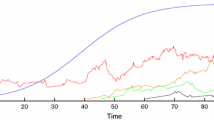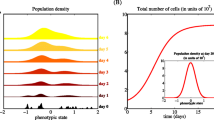Abstract
One of the most popular models for quantitatively understanding the emergence of drug resistance both in bacterial colonies and in malignant tumors was introduced long ago by Luria and Delbrück. Here, individual resistant mutants emerge randomly during the birth events of an exponentially growing sensitive population. A most interesting limit of this process occurs when the population size \(N\) is large and mutation rates are low, but not necessarily small compared to \(1/N\). Here we provide a scaling solution valid in this limit, making contact with the theory of Levy \(\alpha \)-stable distributions, in particular one discussed long ago by Landau. One consequence of this association is that moments of the distribution are highly misleading as far as characterizing typical behavior. A key insight that enables our solution is that working in the fixed population size ensemble is not the same as working in a fixed time ensemble. Some of our results have been presented previously in abbreviated form [12].




Similar content being viewed by others
References
Angerer, W.P.: An explicit representation of the Luria-Delbrück distribution. J. Math. Biol. 42(2), 145–174 (2001)
Antal, T., Krapivsky, P.: Exact solution of a two-type branching process: models of tumor progression. J. Stat. Mech. Theory Exp. 2011(8), P08,018 (2011)
Clayton, E., Doupé, D.P., Klein, A.M., Winton, D.J., Simons, B.D., Jones, P.H.: A single type of progenitor cell maintains normal epidermis. Nature 446(7132), 185–189 (2007)
Coldman, A.J., Goldie, J.H.: A stochastic model for the origin and treatment of tumors containing drug-resistant cells. Bull. Math. Biol. 69(3), 279–292 (1986)
Dewanji, A., Luebeck, E.G., Moolgavkar, S.H.: A generalized Luria-Delbrück model. Math. Biosci. 197(2), 140–152 (2005)
Diaz Jr, L.A., Willians, R.T., Wu, J., Kinde, I., Hecht, J.R., Berlin, J., Allen, B., Bozic, I., Reiter, J.G., Nowak, M.A., Kinzler, K.W., Oliner, K.S., Vogelstein, B.: The molecular evolution of acquired resistance to targeted EGFR blockade in colorectal cancers. Nature 486(7404), 537–540 (2012)
Gentle, J.E.: Random-number generation and Monte Carlo methods. Springer (2003)
Gerrish, P.: A simple formula for obtaining markedly improved mutation rate estimates. Genetics 180(3), 1773–1778 (2008)
Iwasa, Y., Nowak, M.A., Michor, F.: Evolution of resistance during clonal expansion. Genetics 172(4), 2557–2566 (2006)
Kashdan, E., Pareschi, L.: Mean field mutation dynamics and the continuous Luria-Delbrück distribution. Math. Biosci. 240(2), 223–230 (2012)
Kepler, T.B., Oprea, M.: Improved inference of mutation rates: 1. An integral representation for the Luria-Delbrück distribution. Theor. Pop Biol. 59(1), 41–48 (2001)
Kessler, D.A., Levine, H.: Large population solution of the stochastic Luria-Delbrück evolution model. Proc. Natl Acad. Sci. 110(29), 11682–11687 (2013)
Kessler, D.A., Levine, H., Austin, R.H.: Resistance to chemotherapy: patient variability and cellular heterogeneity. Cancer Res. 74, 4663–4670 (2014)
Komarova, N.: Stochastic modeling of drug resistance in cancer. J. Theor. Biol. 239(3), 351–366 (2006)
Landau, L.: On the energy loss of fast particles by ionization. J. Phys. (USSR) 8, 201–205 (1944)
Lea, D.E., Coulson, C.A.: The distribution of the numbers of mutants in bacterial populations. J. Genet. 49(3), 264–285 (1949)
Lenski, R.E., Slatkin, M., Ayala, F.J.: Mutation and selection in bacterial populations: alternatives to the hypothesis of directed mutation. Proc. Natl Acad. Sci. 86(8), 2775–2778 (1989)
Luria, S.E., Delbrück, M.: Mutation of bacteria from virus sensitivity to virus resistance. Genetics 28(6), 491–511 (1943)
Mandelbrot, B.: A population birth-and-mutation process, I: explicit distributions for the number of mutants in an old culture of bacteria. J. Appl. Prob. 11(3), 437–444 (1974)
Moolgavkar, S.H.: Carcinogenesis modeling: from molecular biology to epidemiology. Annu. Rev. Publ. Health 7(1), 151–169 (1986)
Tomasetti, C., Levy, D.: An elementary approach to modeling drug resistance in cancer. Math. Biosci. Eng. 7(4), 905–918 (2010)
Wagle, N., Emery, C., Berger, M.F., Davis, M.J., Sawyer, A., Pochanard, P., Kehoe, S.M., Johannessen, C.M., MacConaill, L.E., Hahn, W.C., Meyerson, M., Garraway, L.A.: Dissecting therapeutic resistance to raf inhibition in melanoma by tumor genomic profiling. J. Clin. Oncol. 29(22), 3085–3096 (2011)
Zheng, Q.: Progress of a half-century in the study of the Luria-Delbrück distribution. Math. Biosci. 162(1), 1–32 (1999)
Acknowledgments
This work was supported by the NSF Center for Theoretical Biological Physics, (Grant No. PHY-1308264). H.L. was also supported by CPRIT Scholar program of the State of Texas, and D.K. was also supported by the Israeli Science Foundation.
Author information
Authors and Affiliations
Corresponding author
Appendix: Recovering \(P_N(m)\) from the Generating Function
Appendix: Recovering \(P_N(m)\) from the Generating Function
The methodology we have adopted yields directly the generating function \(P_N(x)\) and to retrieve \(P_N(m)\) we need to perform a contour integral in the complex plane, as in Eq. (15) for the symmetric pure-birth case, which generalizes (see Eq. (28)) to
in the general asymmetric pure-birth case. The integrand has a branch cut, which we can place on the ray \(z>1\). The contour circles the origin. It is convenient to deform the contour, expanding it outward except where it is “pinched” by the branch cut. The resulting contour is given by \(z(t)=\lim _{\epsilon \rightarrow 0} 1 + t -\epsilon + i\epsilon \tanh t\), \(-\infty <t<\infty \) plus vanishing contributions from infinity. Thus in the limit the integral reduces to the discontinuity of the integrand along the branch cut:
Using standard identities involving hypergeometric functions, we have
As the argument of the hypergeometric function on the right hand side lies between 0 and 1, it is continuous across the real axis. The only discontinuity then arises from the factor \((-t/(1+t))^r\) in the second term. This factor takes the values
Thus, we obtain
The calculation of Eq. (48) follows along the same lines.
For \(r\rightarrow 1\), since
and
we have in this case
This of course also be obtained directly from Eq. (15) via similar methods, where there we label the distribution \(P(m|N)\) since in the death case \(N\) is itself a random variable being conditioned upon.
Rights and permissions
About this article
Cite this article
Kessler, D.A., Levine, H. Scaling Solution in the Large Population Limit of the General Asymmetric Stochastic Luria–Delbrück Evolution Process. J Stat Phys 158, 783–805 (2015). https://doi.org/10.1007/s10955-014-1143-3
Received:
Accepted:
Published:
Issue Date:
DOI: https://doi.org/10.1007/s10955-014-1143-3




